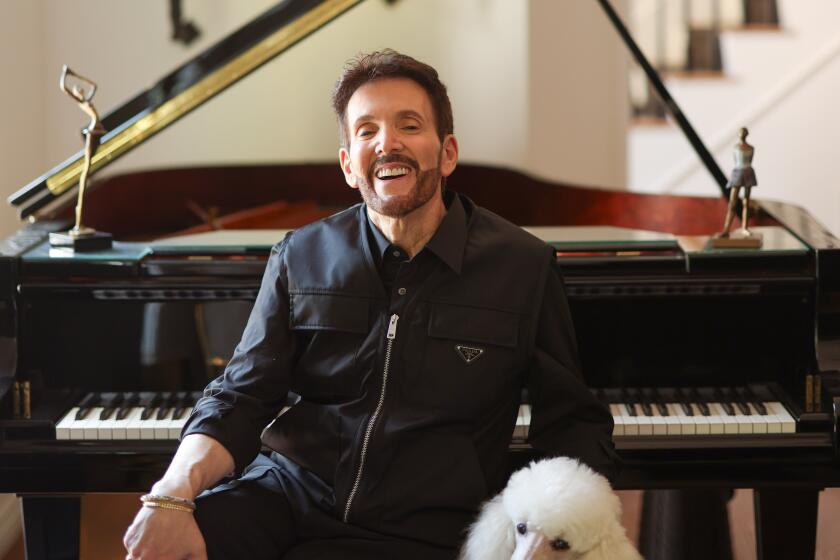A Moving Meditation on Love and Desire From Antonioni
In recent years, Italyâs grand master, Michelangelo Antonioni, has been largely silenced by a 1985 stroke that has left his speech impaired but from which he otherwise recovered. In 1995, he returned to feature filmmaking after a 13-year absence with the assistance of Germanyâs protean Wim Wenders for âBeyond the Clouds,â a shimmeringly beautiful and wise reverie on love and desire, which arrives at last in a regular run.
âBeyond the Cloudsâ is a homage to passion recollected in tranquillity. Antonioniâs usual preoccupation with alienation in modern life remains but is supplemented with an aura of warmth and gratitude on the part of the filmmaker for having lived and loved, coupled with an acceptance of the transient and the elusive that marks so many human encounters.
It is composed of four vignettes drawn from a collection of short stories by Antonioni and adapted to the screen by him with Wenders and the distinguished veteran Tonino Guerra. They are linked by Antonioniâs alter ego, the Director (John Malkovich), whom we meet on a plane bound for Antonioniâs hometown, Ferrara.
The Director tells us that although heâs tired from just completing a film, he nevertheless feels compelled to start searching for ideas for the next one.
âBeyond the Cloudsâ therefore unfolds as a journey that takes the Director from Ferrara to Portofino to Paris and finally to Aix-en-Provence.
The framing story, directed by Wenders, is rich in Antonioniâs feelings about cinema and what it has meant to him.
Each of the filmâs settings is of surpassing beauty and grandeur, captured gloriously by cinematographer Alfio Contini; Antonioniâs style remains inimitable.
Visually, every nuance of feeling and thought is expressed cinematically in the boldest, most distinctive and imaginative use of camera movement and placement.
What counts here, and what gives this film its power, is the intense yet bemused compassion that Antonioni is able to convey about his people and their romantic predicaments.
Matching Memories to Specific Places
Antonioni always has been a master of moods, and his lyrical imagery and pacing have been complemented by Lucio Dalla and Laurent Petitgrandâs poignant score, which deftly includes selections from Brian Eno with U2 and from Van Morrison.
âBeyond the Cloudsâ unfolds as a series of memories rekindled and shared with the audience as the Director visits each place.
In short, he becomes a compelling storyteller as we first meet, in Ferrara, a handsome young man, Silvano (Kim Rossi-Stuart) and a beautiful young woman, Carmen (Ines Sastre), guests at the same hotel.
Their attraction is mutual and immediate. This first episode leaves you feeling that Antonioni is drawing from a personal experience never to be forgotten.
Moving on to Portofino, the Director himself is drawn to a lovely young woman (Sophie Marceau) who works in a clothing boutique and is in turn drawn to him. She tells him that she had murdered her father, stabbing him 12 times, but was subsequently acquitted. The Director proceeds to have a romantic rendezvous with her, but the artist in him, ever in search of perfection, realizes that for him 12 times is excessive--any more than three stabbings offends his artistic sensibilities!
In a Paris bistro, a lovely young woman (Chiara Caselli) enchants an American (Peter Weller) with her story of a group of scientists on an expedition in South America whose native guides refuse to take another step. Three years into Weller and Caselliâs affair, the Americanâs elegant French wife (Fanny Ardant) has finally had it with her husband and moves out of their posh apartment.
Entering the swanky new apartment she has just rented, with her furniture soon to follow, she encounters a man (Jean Reno) standing in stunned silence.
His wife has just done to him what Ardant has done to Weller: abruptly departed with most of their possessions. As Ardant and Reno lock into a gaze, weâre left to wonder whether heâll have to move after all.
As the Director proceeds to Aix-en-Provence, Wenders digresses briefly for an interlude reuniting the stars of Antonioniâs landmark 1961 âLa Notte,â Marcello Mastroianni and Jeanne Moreau.
Mastroianni is a painter, contentedly at work on a landscape in what his friend (Moreau) recognizes as an emulation of Cezanne.
She laments a society that insists on copying everything from master paintings to suitcases, while Mastroianniâs artist explains that for him the thrill is in attempting to recapture the gesture of a genius--which seems a clear homage from Wenders to Antonioni, whose style he and his cameraman, Robby Muller, emulate lovingly in their linking episodes.
In Antonioniâs climactic sequence, the radiant Irene Jacob is resisting ever so politely the overtures of the young man (Vincent Perez) who is beguiled by her at first sight.
Itâs enchanting as these two young people discover that while she may be scared of life, he may in turn be afraid of death.
âBeyond the Clouds,â in all ways an enthrallingly exquisite film, leaves us feeling that Antonioni may well see himself in both characters.
* Unrated. Times guidelines: language, adult themes, some sex and nudity.
âBeyond the Cloudsâ
John Malkovich: The Director
Kim Rossi Stuart: Silvano
Ines Sastre: Carmen
Sophie Marceau: Girl
Fanny Ardant: Patricia
Peter Weller: Husband
Chiara Caselli: Mistress
Irene Jacob: Girl
Vincent Perez: Boy
Jean Reno: Carlo
Marcello Mastroianni: Painter
Jeanne Moreau: Friend
A Sceneries Entertainment presentation of an Italo-Franco-German co-production: Sunshine/Cine. B (Paris)/Cecchi Gori Group, Tiger Cinematografica (Rome)/Road Movies (Berlin)/France 3 Cinema in association with the Centre National de la Cinematografic, Canal Plus, Ard/Degeto Film, Eurimages. Directors Michelangelo Antonioni and Wim Wenders. Produced by Stephane Tchalgadjieff, Philippe Carcassonne. Executive producers Danielle Gegauff Rosencrantz, Brigitte Faure, Pierre Reutfeld. Screenplay Tonino Guerra, Antonioni, Wenders; based on Antonioniâs collection of short stories âQuel Bowling sul Tevere.â Camera Alfio Contini (for Antonioni), Robby Muller (for Wenders). Editors Claudio Di Mauro (for Antonioni), Peter Przygodda, Luciano Segura (for Wenders). Music Lucio Dalla, Laurent Petitgrand, Van Morrison, U2/Brian Eno. Costumes Esther Walz. Production designer Thierry Flamand. Executive consultant Enrica Fico. In English, Italian and French, with English subtitles. Running time: 1 hour, 53 minutes.
Exclusively at the Music Hall, 9036 Wilshire Blvd., Beverly Hills, (310) 274-6869.
More to Read
Only good movies
Get the Indie Focus newsletter, Mark Olsen's weekly guide to the world of cinema.
You may occasionally receive promotional content from the Los Angeles Times.










